LINKS
- Attack of the 50-Year-Old Comics
- Super-Team Family: The Lost Issues
- Mark Evanier's Blog
- Plaid Stallions
- Star Trek Fact Check
- The Suits of James Bond
- Wild About Harry (Houdini)
Fifty years ago today, a measly quarter bought me a comic book that kicked off my one my all-time favorite Superman stories. Starting with Superman #296, the writing team of Cary Bates and Elliott S! Maggin posed our hero with an impossible choice; whether to spend his every waking moment as Earth’s greatest hero with all the glory and grief that entails or permanently retire to a comparatively carefree life as a powerless Clark Kent.
Does Superman owe the world 24-hour protection, or does the Man of Steel deserve an occasional break? What kind of man might Clark Kent become, free from need to forever play the cowardly nebbish? Can Lois, Jimmy and other friends ever truly understand the Last Son of Krypton, much less provide him with the emotional support any healthy person needs? These questions will all be examined over the course of this fondly remembered storyline. And if the plot device driving this existential crisis is ultimately standard comics fare, it does allow the writers to address issues central to the Superman mythos and along the way give a certain mild-mannered reporter perhaps his finest hour.
But I’m getting ahead of myself. First, we have a very nice cover by Bob Oksner:
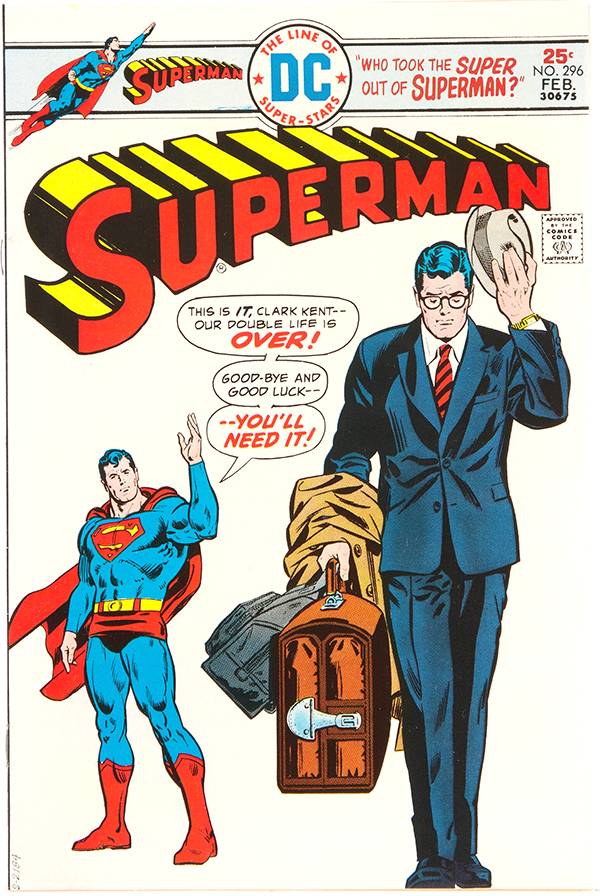
We open our saga with a flashback to baby Kal-El’s arrival on Earth and learn that on that same day, another spacecraft landed somewhere in the American West. In the latter case, however, what emerged was not a Kryptonian infant but what seemed to be an adult human male clad in a business suit. And where the kindly Kents were rewarded that day with the love of a foster son, the prospectors who found the other ship were summarily disintegrated for their troubles.
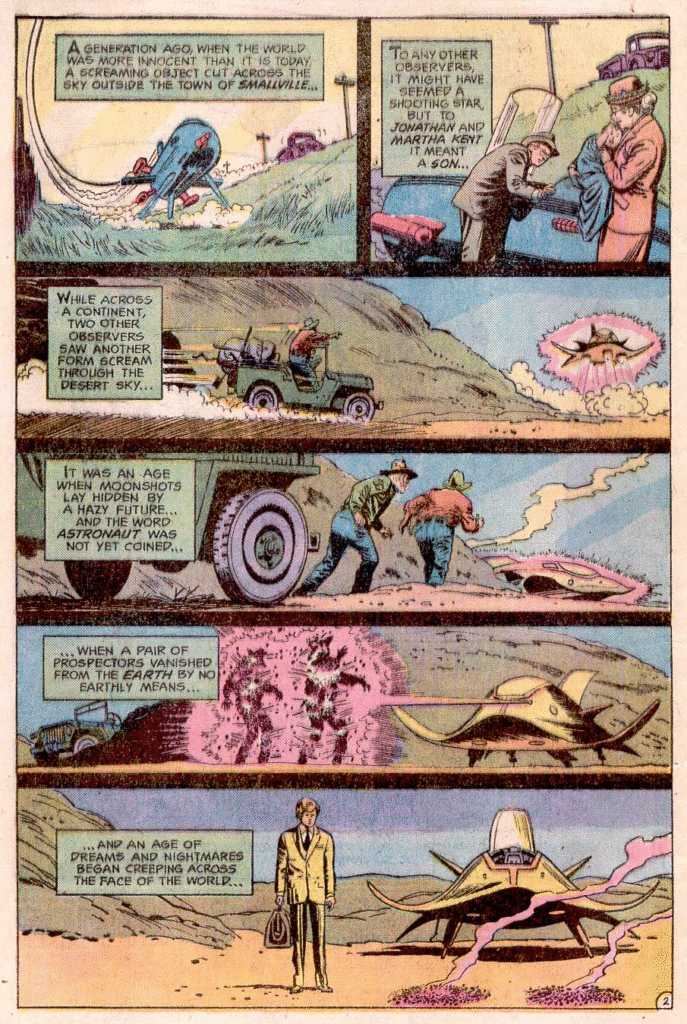
As the years wore on, Kal-El grew to manhood in the glare of the spotlight with his amazing feats observed by an adoring public, but also by the mysterious alien visitor who, in contrast to our hero, preferred to keep a low profile, moving from place in obscurity while reporting regularly to his off-world masters.
Here we get an interesting “soft reboot” of the super-mythos as Superboy meets the President of the United States, who while never mentioned by name is very obviously John F. Kennedy.

Of course, this casual reference contradicts earlier tales that established Superman and JFK as adult contemporaries, with the president even serving as a sort of “pal” who helped Superman preserve his secret identity. Does the above sequence suggest that Bronze Age Superman and Silver Age Superman are in fact two different characters, one a mere youth in the 1960s while the other was already well into his career? At least that would explain how the receding hairline and broader waistline of Curt Swan’s 60s Superman were replaced with a fuller mane and slimmer physique in the 1970s. But if so, which fellow is the “Earth-1” Superman and on what Earth does the other one live? Nevermind, there’s no time to indulge such ponderings as we must move on to the next scene. Flash forward and we’re now in 1975, so cue the killer bees. Anyone who lived through this era will recall the cultural obsession with these murderous insects, which the media constantly assured us were on their way to bring death and destruction to the United States at any moment. True to form, Hollywood had exploited this mania earlier in the year with the movie “Killer Bees” (starring Gloria Swanson of all people!) while The Savage Bees, Terror Out of the Sky and The Swarm were all on the horizon. And yet my parents still insisted that I put down my comic books and go play outside, apparently fine with the idea of placing their first-born son in mortal peril. But anyway, back to the story; the deadly swarm is on its way to Metropolis, but happily the now-adult Superman is on the case.

After a brief side mission to stop an act of piracy at sea, Superman disposes of the bees (we never see exactly how) before changing to Clark Kent to meet Lois Lane and Steve Lombard for a karate lesson (because, again, 1975). As this activity will involve changing clothes in a locker room, he takes a moment to hide his Superman costume by compressing it down to the size of a pill and placing it under his tongue (!).
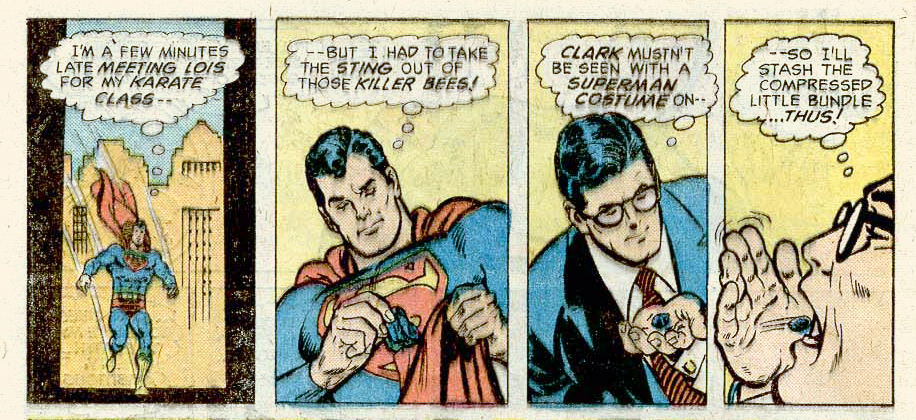
Playing on the sidewalk in front of the karate school, a youngster throws his football too high for his friend to catch. Never one to miss a chance to show off, former quarterback Steve Lombard races into the street to catch it, heedless of the taxicab speeding up behind him. Feigning clumsiness, Clark knocks Steve clear of danger and absorbs the impact himself, but for once he does not emerge unscathed, waking later to find himself in a hospital bed, where a doctor has just successfully penetrated his skin with a hypodermic needle.
Stunned by this turn of events and eager to leave the hospital, Clark takes the first available opportunity to change into the Superman suit still tucked under his tongue. Once removed from his mouth, it expands on contact with the air ala Barry Allen’s Flash costume.
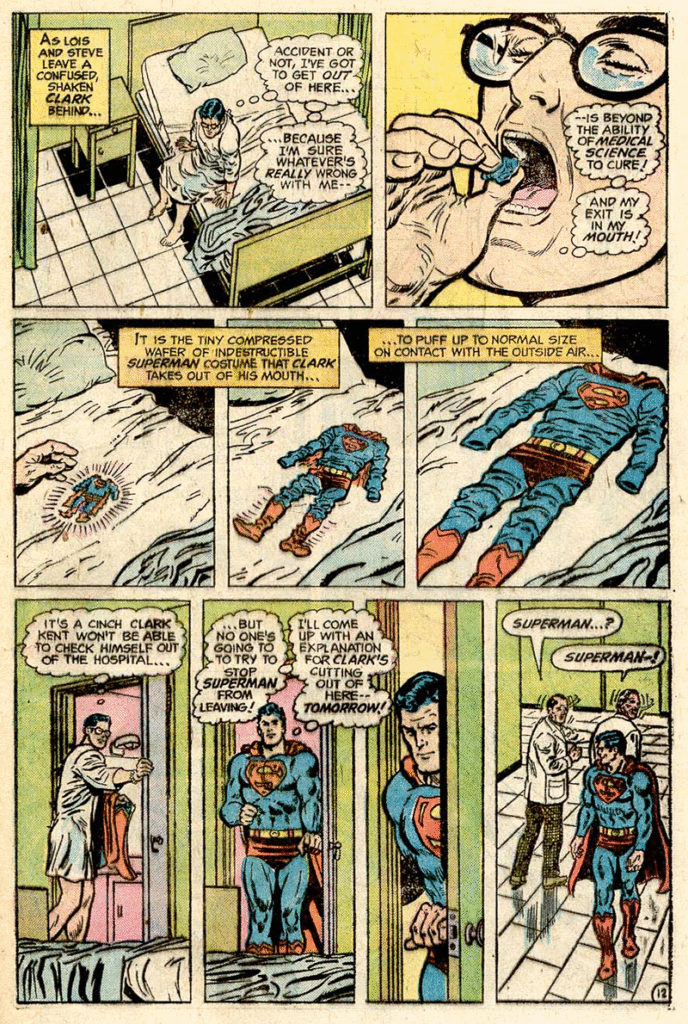
Happily, Clark didn’t swallow the suit when he got hit by that car or else he’d have a much longer wait to retrieve it, and under decidedly less pleasant circumstances. It’s also fortunate no medical personnel decided to inspect his mouth to make sure he hadn’t bitten or swallowed his tongue in the accident, which could have led to the costume’s discovery. Also, does air never enter Clark’s mouth? Either this guy doesn’t breathe or he should have choked on a full-sized costume by now.
Anyway, only after walking out of the hospital does Superman realize he has no exit strategy; in that outfit he’ll look pretty silly walking the streets instead of flying, and anyway he can’t simply waltz into to Clark Kent’s apartment without compromising his secret identity. As he ponders this dilemma, a gang of crooks flies by on airborne platforms carrying stolen loot, leading bystanders to wonder why he’s not taking action. Bemoaning his powerless state, Superman grips a lamppost in frustration, and when it bends (“like taffy” in the obligatory wording), he realizes he’s somehow become super again.
Making short work of the airborne crooks, Superman returns to Clark’s apartment to test his theory that against all logic some mysterious effect has rendered him powerless when dressed as Clark Kent, but still mighty when dressed as Superman (despite, as he notes, having told children for years that the power of Superman is NOT in the costume).
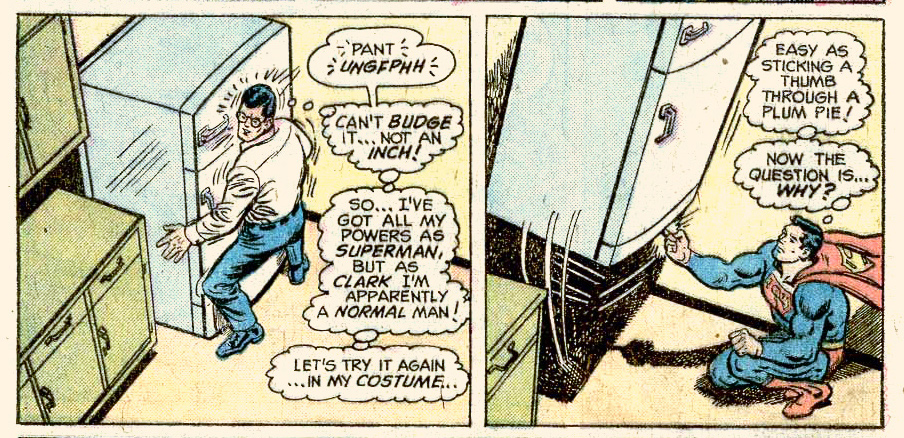
Having promised his elderly neighbor Mrs. Goldstein that he’d take her to a tenant meeting, Clark dons his street clothes again just in time to get a phone call from the building’s doorman. The doorman reports that he earlier allowed delivery men to leave a crate in Kent’s apartment, and sure enough there’s a seven-foot wooden crate towering right behind him, which you’d think he’d have noticed before now, but hey, he’s got a lot on his mind. Suddenly the crate bursts open to reveal a killer robot, sent by Intergang as retribution for a series of exposes Clark has written. In the ensuing battle, Clark realizes that his powers are nullified so long as he wears even one item of civilian clothing over the super-suit.
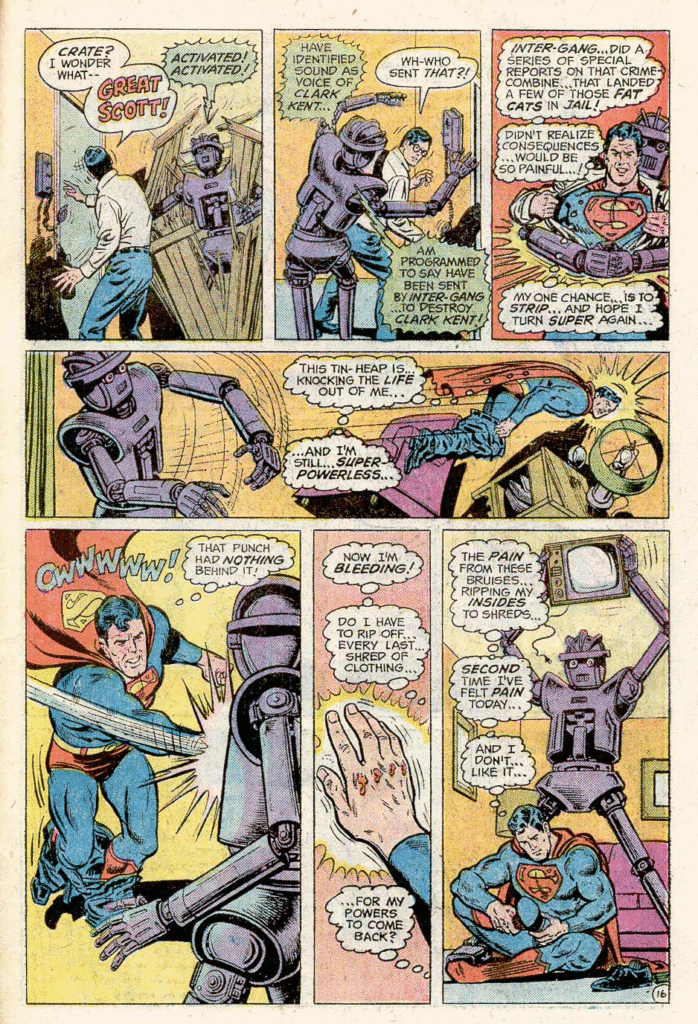
He sheds his last sock and shoe a split second before that TV set splits his skull, thank goodness, then he quickly converts the robot into a scrap heap. So how, you may ask, did Clark manage get his pants off over his shoes? And does he really wear socks over his Superman boots, and shoes over the socks? Well guess what, you ask too many questions. Let’s move along.
Mrs. Goldstein is at the door now, waiting to be taken to the tenant meeting. On the way, she wonders alout if they’ll finally get to meet their mysterious neighbor “Mr. Xavier,” who we learn is actually “Xviar,” the alien from the start of the story, still observing Superman’s career but now from a much closer vantage point. As Xviar makes his report back to his alien bosses, we gather that whatever’s going on, he is responsible, and somehow the scheme involves the destruction of the Earth. Meanwhile, Clark ponders a more immediate problem: must he abandon his secret identity to be Superman all the time, or does he hang up the super-suit to live out his days as a mere mortal?

It was a rare thing in this era for a Superman tale to be stretched out over four issues, but even with the extra breathing room, this issue packs a lot in compared to modern “decompressed” tales. Things are about to become a lot more interesting in the next chapter, but even in this first installment we already have an intriguing mystery, several fun moments and some wonderful art. To a certain extent, Curt Swan was always at the mercy of his inkers; handsomely enhanced by George Klein, tranquilized into a bland stupor by Jack Abel, infused with new life and relevance by Murphy Anderson and all too soon sucked dry of all life and energy by Frank Chiaramonte. For me, Bob Oksner rates as one of his stronger collaborators, adding to Swan’s already masterful anatomy and expressive faces a certain sharpness and polish that works very well. In the ensuing chapters, Oksner’s talent for drawing beautiful females will make Lois Lane appeal to me for the first time ever. Working against these fine efforts, however, are the penny-pinching production standards and lousy paper that will unfortunately come to define DC’s late 70s output.
So, what’ll it be? Will Superman give up the eternal headache of maintaining a dual identity? Will Clark Kent finally escape the shadow of his super alter-ego, free at last to wear groovy plaids? Will millions die from killer bee stings while waiting in vain for Clark to pass an accidentally swallowed super-suit through his digestive system? Will those delivery men file a workman’s comp claim for back injuries sustained while schlepping a half-ton robot to a third-floor apartment?
Tune in next month to find out.